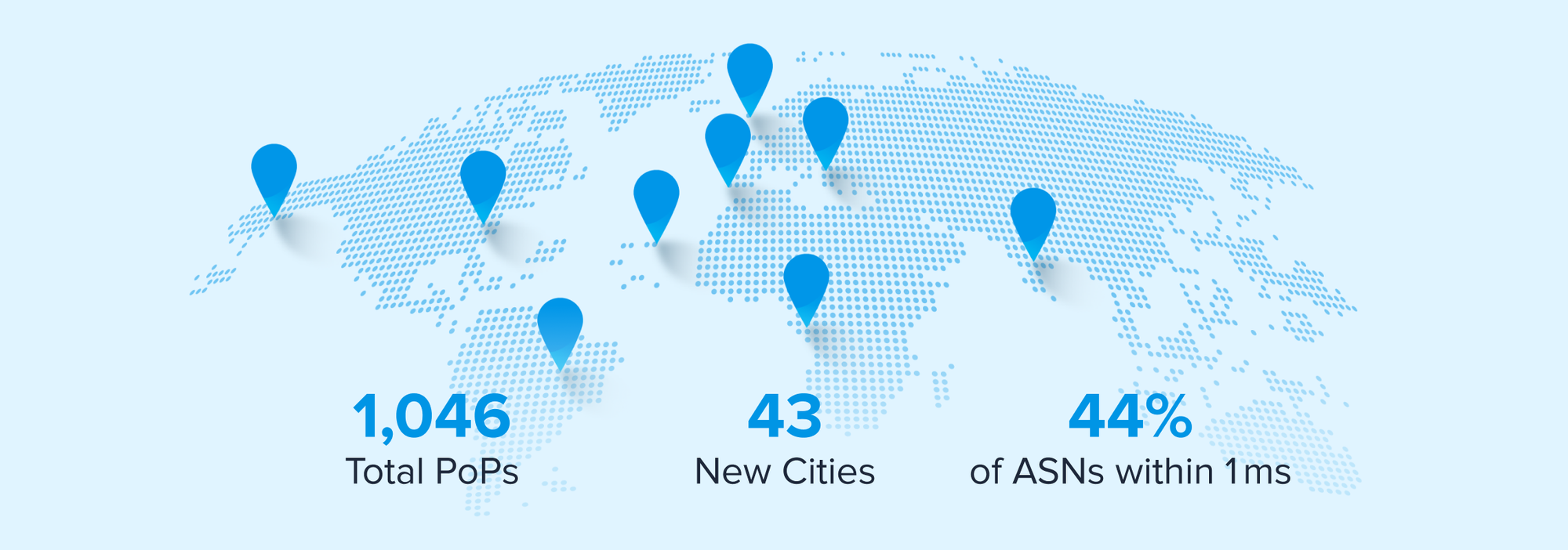Most IP data providers rely on static databases and self-reported information. At IPinfo, we take a different approach: we measure the internet directly.
That’s why we built ProbeNet, our internet measurement platform. It gives us direct insight into how IP addresses behave across the internet: how fast they respond, how they route, and how their paths shift over time. Every dataset we offer: geolocation, ASN details, carrier classification, and more, is made stronger by what we can verify through active measurement.
In Q2 2025, we expanded ProbeNet by 96 new points of presence (PoPs) across 24 countries and 43 new cities, bringing our total footprint to 1,046 globally distributed measurement nodes.
Each of these PoPs runs tests like latency sampling, traceroutes, and TLS handshakes against millions of IP addresses, feeding fresh data into the systems that power our products. It’s a quiet layer of verification beneath everything we offer.
Why We’re Investing in ProbeNet
When we talk about accuracy at IPinfo, we mean it. ProbeNet is one of the ways we go beyond passive data sources — like WHOIS records or static feeds — and actively verify how IP addresses behave.
For example, latency measurements help refine IP geolocation in regions where path distance or routing asymmetry can introduce errors. Traceroutes help us understand how networks connect and how their paths evolve. And real-time monitoring lets us detect infrastructure changes, like new IP blocks, mobility patterns, or unusual behavior, more quickly than relying on registry updates alone.
As we continue expanding, ProbeNet ensures that what we show in our APIs and datasets isn’t just based on assumptions — it’s based on live measurements.
Highlights from Q2 2025
Our Q2 expansion focused on two things: increasing regional coverage and closing visibility gaps. We launched first-ever ProbeNet nodes in:
- Cabo Verde, in Praia
- Democratic Republic of the Congo, in Kinshasa
- Kosovo, in Pristina
We also expanded our footprint in 21 countries where ProbeNet was already present, including:
- United States – new PoPs in Anchorage, Charlotte, Highland, and more
- United Kingdom – new coverage in Birmingham, Leeds, Manchester, and multiple sites in London
- India – added nodes in Ahmedabad, Hyderabad, and Jaipur
- Brazil – new cities like Chapecó, Muriaé, and Fortaleza
- Poland, the Philippines, Spain, Canada, Portugal, and others saw similar growth
This rollout not only improves performance but also increases the reliability of our IP-to-location and IP-to-network mappings in those regions.
Metrics that Matter
Behind this expansion is a growing infrastructure engine:
- 96 new PoPs deployed
- 24 countries that received new PoPs
- 43 new cities added to our measurement mesh
- 3 countries joined ProbeNet for the first time
- 1,046 active PoPs globally
- 5.2 billion active measurements per month
These new vantage points bring us physically closer to the IPs we measure. That’s why we now reach 44% of the world’s ASNs within 1 millisecond.
What Comes Next
In Q3, our infrastructure team is working to make our data even better. Our updated goal is to bring 50% of the world’s ASNs within 1 millisecond round-trip time, and 80% within 5 milliseconds. This milestone will expand our ability to validate geolocation, network ownership, and edge behavior with greater confidence.
We're doing this by densifying coverage, increasing regional provider diversity, and expanding ProbeNet to cover 140 countries and 460 cities. This also lays the groundwork for improved IPv6 accuracy and facility-level IP geolocation in future quarters.
“Everyone talks about accuracy but we’re the only ones building the infrastructure to deliver it. Reaching over 1,000 global PoPs is a major milestone for IPinfo’s ProbeNet. Every new node enhances our visibility into the internet, helping us generate more precise and reliable internet data.”
— Abdullah, Developer Relations at IPinfo
Why It Matters
If you rely on IP data — whether for personalization, localization, compliance, network optimization, or infrastructure planning — ProbeNet directly enhances the accuracy of every data point we deliver.
We provide accurate, verifiable information about IP addresses and the infrastructure they belong to, based on what we can measure across the internet. ProbeNet makes that possible, and Q2 strengthened our global coverage with greater density and reach than ever before.
Learn More
To understand how ProbeNet is built and deployed, read our deep dive.
About the author

As the product marketing manager, Fernanda helps customers better understand how IPinfo products can serve their needs.
